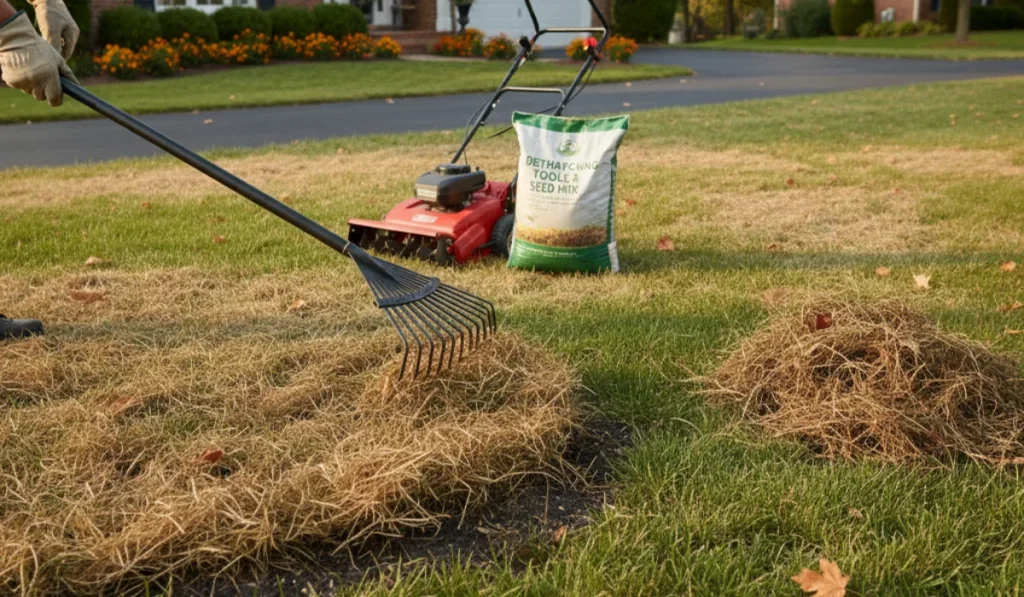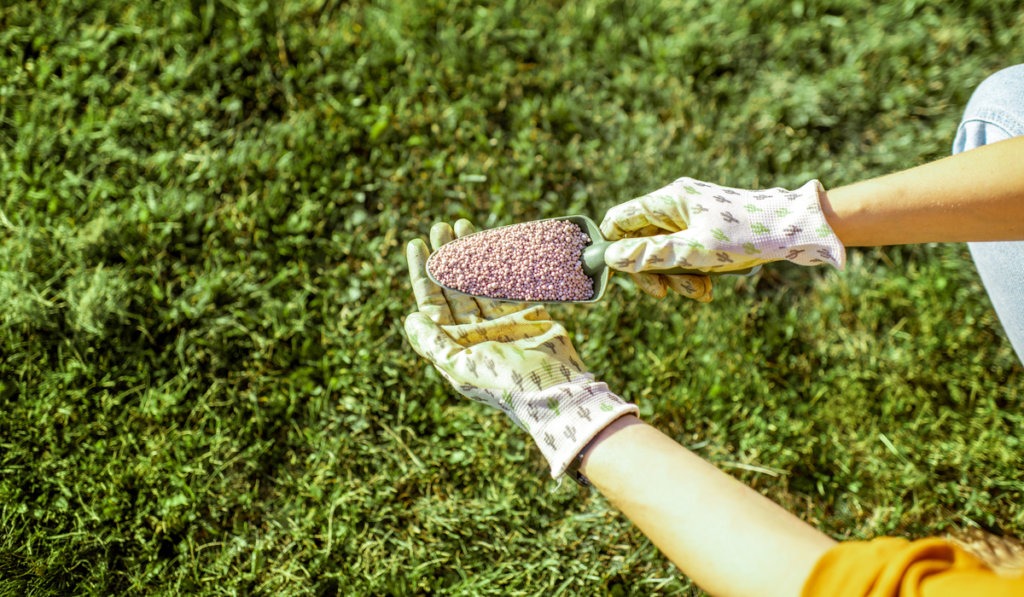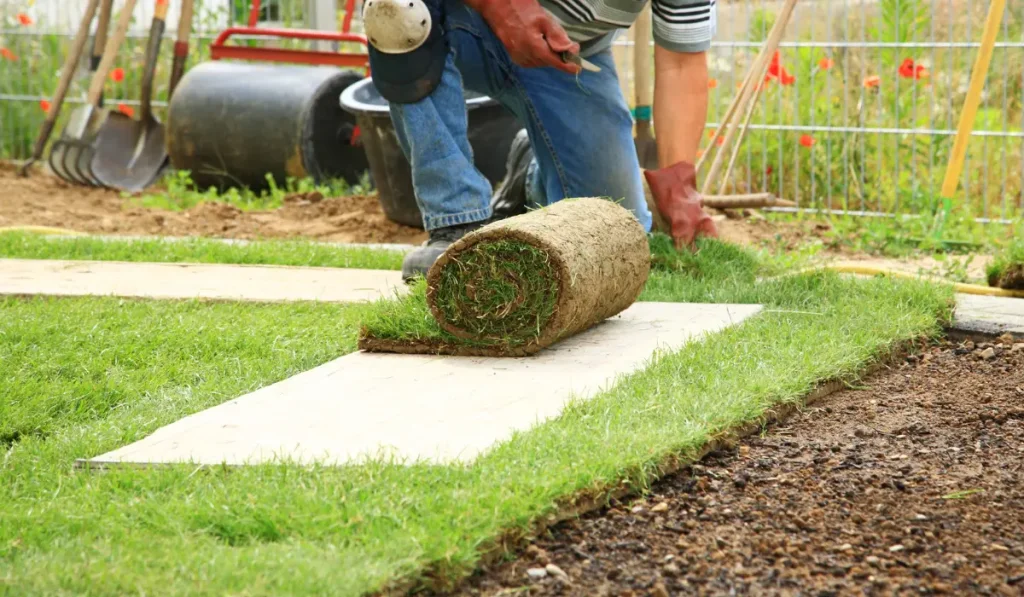Every healthy lawn faces a common enemy: weeds. These uninvited guests compete with your turfgrass for sunlight, nutrients, and water. And they don’t give up easily. If you’ve ever spotted dandelions dotting your front yard or crabgrass spreading like wildfire across your backyard, you know how fast a minor problem can turn into a serious weed problem.
A well-kept lawn doesn’t just improve curb appeal, it adds usable space, boosts property value, and gives you a place to relax. But the moment weeds take hold, everything starts to feel like a losing battle. One day, it’s just a few dandelions. Next, you’re spotting patches of crabgrass, creeping clumps of spurge, and odd-looking plants you can’t even name.
The truth is, weeds aren’t just ugly, they’re opportunistic. They spread fast in thin turf, overwatered areas, or places where mowing has been inconsistent. And once they establish themselves, getting rid of them can feel like an ongoing task.
The good news? You don’t have to live with them forever. By learning how to recognize the weeds that are most common in your area and choosing the right control methods, whether that’s hand-pulling, applying herbicide, or improving your watering routine, you can get ahead of the problem before it takes over.
This guide breaks down the most common lawn weeds in the U.S., how to identify them, and what to do to get rid of them for good. Whether you’re working with cool-season turf in the north or warm-season grasses in California, this guide is your blueprint for weed-free grass.
How to Identify Lawn Weeds
Weeds fall into three categories:
- Broadleaf weeds: Think wide, flat leaves and flowers (like dandelions or clover).
- Grassy weeds: These look like grass but grow differently (like crabgrass or goosegrass).
- Sedges: Grass-like plants with triangular stems (like nutsedge).
Correct identification is essential. The best control method depends on the weed’s growth type, annual, biennial, or perennial, as well as its physical traits, root system, and preferred growing conditions.
Top 10 Most Googled Lawn Weeds in the U.S.
Before diving into photos and treatment tips, we wanted to know: Which lawn weeds do Americans search for the most?
To find out, we analyzed Google Trends data across the U.S. over the past 12 months. The results might surprise you:
Key Insight: While you might expect dandelions or crabgrass to top the list, weeds like plantain and spurge generated the highest search interest on average nationwide, likely due to how aggressively they spread in compacted or dry soil.
15 Common Lawn Weeds (and What to Do About Them)
1. Crabgrass (Digitaria spp.)
- Type: Grassy weed
- Life Cycle: Summer annual
- Look for: Low, spreading growth, thick, light green blades, coarse texture
Crabgrass germinates in early spring and thrives in compacted soil and full sun. It becomes especially aggressive in late spring and early summer.
Control Tips: Apply pre-emergent herbicide before seeds germinate (around 55°F soil temperature). Keep turf thick through proper mowing and watering.
2. Dandelion
- Type: Broadleaf perennial
- Look for: Bright yellow flowers, jagged leaves in a rosette, deep taproot
Dandelions are easy to spot and tough to remove thanks to their long taproot.
Control Tips: Use a broadleaf herbicide, or pull by hand with a weed tool. Be sure to remove the entire root.
3. Nutsedge
- Type: Sedge
- Look for: Light green, glossy leaves, triangular stems, fast growth after rain
Also called yellow nutsedge, it spreads through tubers and thrives in poorly drained areas.
Control Tips: Improve drainage. Apply a sedge-specific post-emergent herbicide.
4. Chickweed
- Type: Broadleaf winter annual
- Look for: Dense mats of small green leaves and tiny white flowers
Chickweed germinates in the fall, then grows through winter.
Control Tips: Apply pre-emergent herbicide in fall. For established weeds, use a broadleaf herbicide.
5. Ground Ivy / Creeping Charlie
- Type: Broadleaf perennial
- Look for: Purple flowers, round, scalloped leaves, creeping stems
Thrives in shady areas and moist soil.
Control Tips: Spot treat with a broadleaf herbicide in spring or fall. Improve airflow and reduce shade when possible.
6. Goosegrass
- Type: Grassy summer annual
- Look for: Flattened rosettes, white or silver center, coarse seed heads
Grows in heavily trafficked or compacted soil.
Control Tips: Aerate the soil and apply pre-emergent herbicide later in spring.
7. Henbit
- Type: Winter annual
- Look for: Square stems, purple tubular flowers, fuzzy, rounded leaves
Often mistaken for ground ivy, but henbit doesn’t spread via creeping stems.
Control Tips: Fall pre-emergent followed by spot spraying in early spring.
8. Plantain
- Type: Broadleaf perennial
- Look for: Oval leaves forming a rosette, a tall central stalk
Grows best in compacted soil with poor drainage.
Control Tips: Aerate and use a broadleaf herbicide or remove with a digging tool.
9. Quackgrass
- Type: Grassy perennial
- Look for: Coarse texture, rhizomes, blue-green blades
Invasive and fast-spreading.
Control Tips: Remove the entire root system. Use a non-selective herbicide and reseed affected areas.
10. White Clover
- Type: Broadleaf perennial
- Look for: Three-leaf clusters, white flowers, low growth habit
It can enrich nitrogen-poor lawns but becomes invasive.
Control Tips: Boost soil nitrogen. Spot treat with broadleaf herbicide.
11. Bindweed
- Type: Broadleaf perennial
- Look for: Heart-shaped leaves, twining vines
Spreads through both roots and seeds.
Control Tips: Repeated hand-pulling and selective herbicide applications are essential.
12. Spurge
- Type: Summer annual
- Look for: Reddish stems, low-growing mats
Pops up during hot, dry weather.
Control Tips: Maintain healthy turf and use pre-emergent herbicide in spring.
13. Wild Violet
- Type: Broadleaf perennial
- Look for: Heart-shaped leaves, shiny texture, purple flowers
Spreads by rhizomes and reseeds aggressively.
Control Tips: Use a broadleaf herbicide in early fall. Repeat applications may be necessary.
14. Annual Bluegrass
- Type: Grassy winter annual
- Look for: Light green blades, visible seed heads, thrives in cool weather
Grows in bare spots and shady areas.
Control Tips: Apply pre-emergent in late summer or early fall.
15. Oxalis / Yellow Woodsorrel
- Type: Broadleaf perennial
- Look for: Clover-like leaves, yellow flowers, forms mats
Often found in stressed or overwatered turf.
Control Tips: Spot spray with herbicide or pull early before it spreads.
Weed Prevention Strategies
1. Mowing
Keeping your mower blade sharp is one of the simplest ways to protect your lawn from weeds. Dull blades tear the grass, making it more vulnerable to stress and disease, both of which open the door to unwanted growth.
Mowing height also matters. During the warmer months, it’s best to mow high. Taller grass shades the soil, helping to block sunlight from reaching weed seeds. This reduces germination and supports a deeper root system that can naturally outcompete invasive plants.
2. Watering
Proper watering supports healthy turf and discourages most weed varieties. Lawns benefit more from deep, infrequent watering than from short, daily sprinkles.
Aim to give your lawn about one inch of water per week, including rainfall. This encourages grass roots to grow deep, making the lawn more drought-resistant and less prone to shallow-rooted weeds like chickweed or spurge.
Avoid watering in the evening, as excess moisture overnight can encourage disease.
3. Fertilization
Fertilizing your lawn without a plan can do more harm than good. Too much nitrogen encourages fast, shallow growth that’s prone to stress, while not enough can leave your turf thin and open to invasion from opportunistic weeds like clover.
The best approach is to use the results of a soil test to determine exactly what your lawn needs. Feeding your lawn at the right times of year, generally spring and fall, helps maintain thick, healthy turf that’s far more effective at keeping weeds out on its own.
4. Aeration
Over time, soil becomes compacted from foot traffic, heavy rainfall, or poor drainage. Compacted soil limits airflow and makes it harder for roots to grow deep. When this happens, weeds that tolerate poor soil, like plantain and goosegrass, start to move in.
Aerating your lawn once or twice a year, typically in spring or fall, relieves this compaction and gives your grass room to breathe and grow. After aerating, it’s smart to overseed to help fill in thin areas before weeds have a chance to establish.
Cool-Season vs. Warm-Season Lawns
Cool-Season Grasses (e.g., fescue, rye, bluegrass)
Cool-season grasses grow most actively during the spring and fall when temperatures are moderate. They prefer climates with cold winters and mild summers, making them common in northern and central regions of the U.S. These grasses can struggle during hot summer months, becoming stressed and more vulnerable to invasive weeds like crabgrass or spurge.
Proper care during their active seasons is key. This means mowing at the higher end of the recommended range, watering deeply but infrequently, and fertilizing in early fall to promote strong root growth. Overseeding in the fall also helps thicken the lawn and crowd out weeds before they get established.
During summer, it’s best to reduce mowing frequency and avoid heavy fertilization, as excess stress can thin the lawn and invite weed problems. Maintaining a healthy, dense stand of cool-season grass creates a natural barrier against weed invasion year-round.
Warm-Season Grasses (e.g., Bermuda, zoysia, St. Augustine)
Warm-season grasses thrive in hot climates and reach their peak growth during late spring and summer. Common in southern and western regions like California, these grasses are naturally more heat- and drought-tolerant than their cool-season counterparts.
Bermuda and zoysia, for example, grow thick and dense when properly maintained, creating a solid defense against weeds. St. Augustine, while more shade-tolerant, still performs best with ample sun.
These grasses go dormant in winter, turning brown and becoming more vulnerable to winter annual weeds like chickweed and henbit. To stay ahead of seasonal weed issues, apply pre-emergent herbicides in late winter before temperatures start to rise.
Fertilization should align with the active growing period, usually from late spring through early fall, to support strong, vigorous turf. Regular mowing, ideally every 5–7 days, and periodic aeration will keep warm-season grasses resilient and better equipped to outcompete weeds through the growing season.
Natural Weed Control: Is It Worth It?
Pros
Natural weed control methods are appealing for homeowners looking to avoid synthetic products. These approaches are often safer for pets, kids, and pollinators, making them a good fit for families with high lawn traffic. Using natural options can also reduce runoff into storm drains and nearby water sources.
For those committed to organic gardening or maintaining a more eco-friendly yard, natural weed control aligns with long-term sustainability goals. Additionally, many of these methods, such as hand-pulling or mulching, double as routine lawn maintenance practices.
Cons
While these methods have their benefits, natural weed control methods often require more time, effort, and consistency to be effective. They may offer only temporary suppression rather than full eradication. For example, household vinegar can damage weed leaves on contact but won’t affect deep taproots or rhizomes, meaning the weed will often regrow.
Similarly, while corn gluten meal has shown some potential as a pre-emergent, results are inconsistent and heavily dependent on precise timing and environmental conditions. Most natural methods also need frequent reapplication, especially after rainfall or mowing.
Natural Options
Some of the most commonly used natural weed control options include physical removal, boiling water, vinegar-based sprays, and mulching.
- Hand-pulling remains one of the most effective ways to deal with isolated broadleaf weeds like dandelions or plantain, especially when the soil is moist.
- Pouring boiling water directly onto small weeds in cracks or driveways can kill them quickly, but this method isn’t practical for larger lawn areas.
- Vinegar sprays may help with surface-level weeds but should be used cautiously to avoid damaging nearby grass or ornamentals.
- Mulch is highly effective in flower beds and around trees, as it blocks sunlight and retains soil moisture, reducing the conditions weeds need to grow.
Bottom Line
Natural weed control can work well when integrated into a broader lawn care strategy, especially for those willing to stay consistent and do a little extra manual labor. However, for widespread infestations or persistent perennial weeds, relying solely on natural methods might not deliver the long-term results you’re looking for. In those cases, combining natural practices with targeted synthetic herbicide treatments may strike the best balance between safety, effectiveness, and ease.
Weed Control Calendar
Final Thoughts
Lawn weeds are a challenge no matter where you live. Whether you’re dealing with spurge in a sunny Arizona yard, wild violet in the Midwest, or chickweed creeping through your lawn in the Northeast, the fundamentals of control are the same: build healthy turf, identify weeds accurately, and apply the right treatments at the right time. A thick, well-maintained lawn is your best long-term defense against unwanted growth.
For homeowners across the U.S., applying seasonal pre-emergents, mowing at the correct height, watering deeply, and staying on top of lawn nutrition will go a long way in keeping weeds in check.
If you’re in California and looking to start fresh with premium sod or need help identifying the best turfgrass for your region, SodLawn is here to help. With a wide range of drought-tolerant and regionally suited options, we make it easy to build a lawn that naturally keeps weeds out and looks great year-round.
FAQs
Can I just pull weeds?
Yes, for isolated broadleaf weeds like dandelion or plantain. But perennials and spreaders like creeping Charlie require stronger control.
Why do weeds come back every year?
Either the root system wasn’t removed, or the turf is thin and stressed, giving seeds a chance to germinate.
Do I need herbicide every year?
Yes. Pre-emergent herbicide is essential to keep annual weeds from returning.



